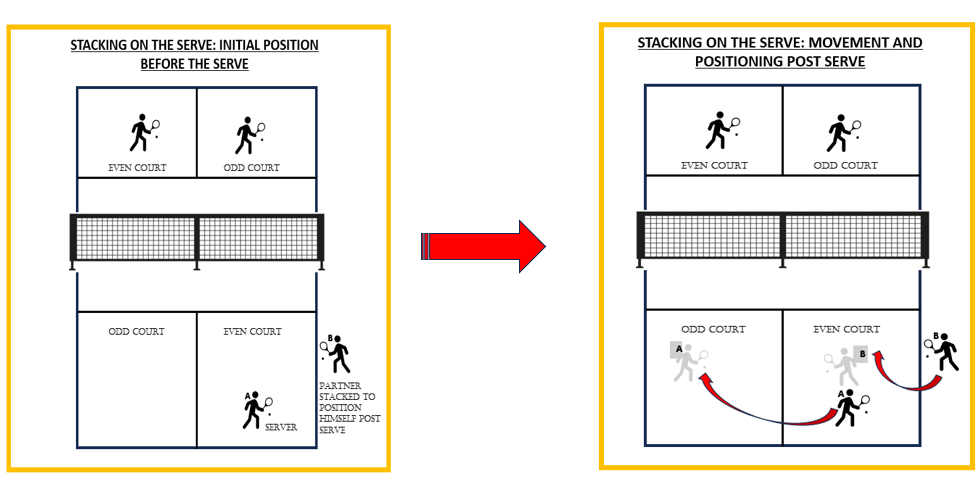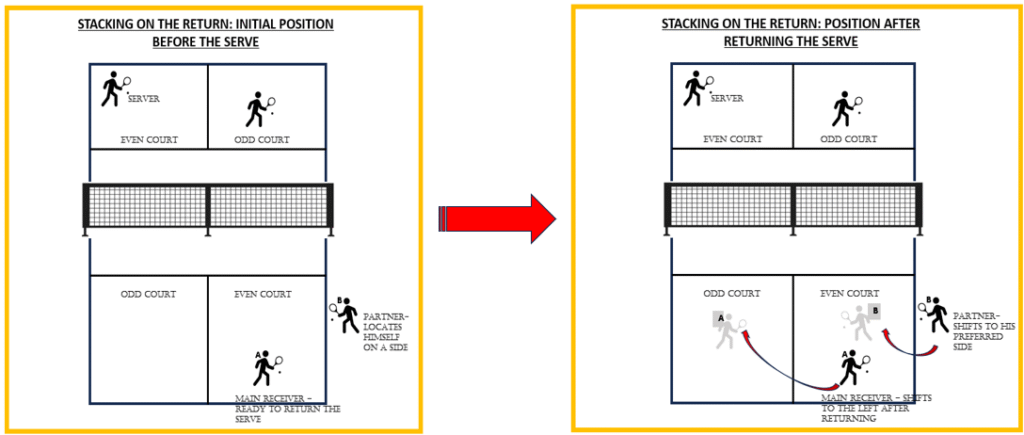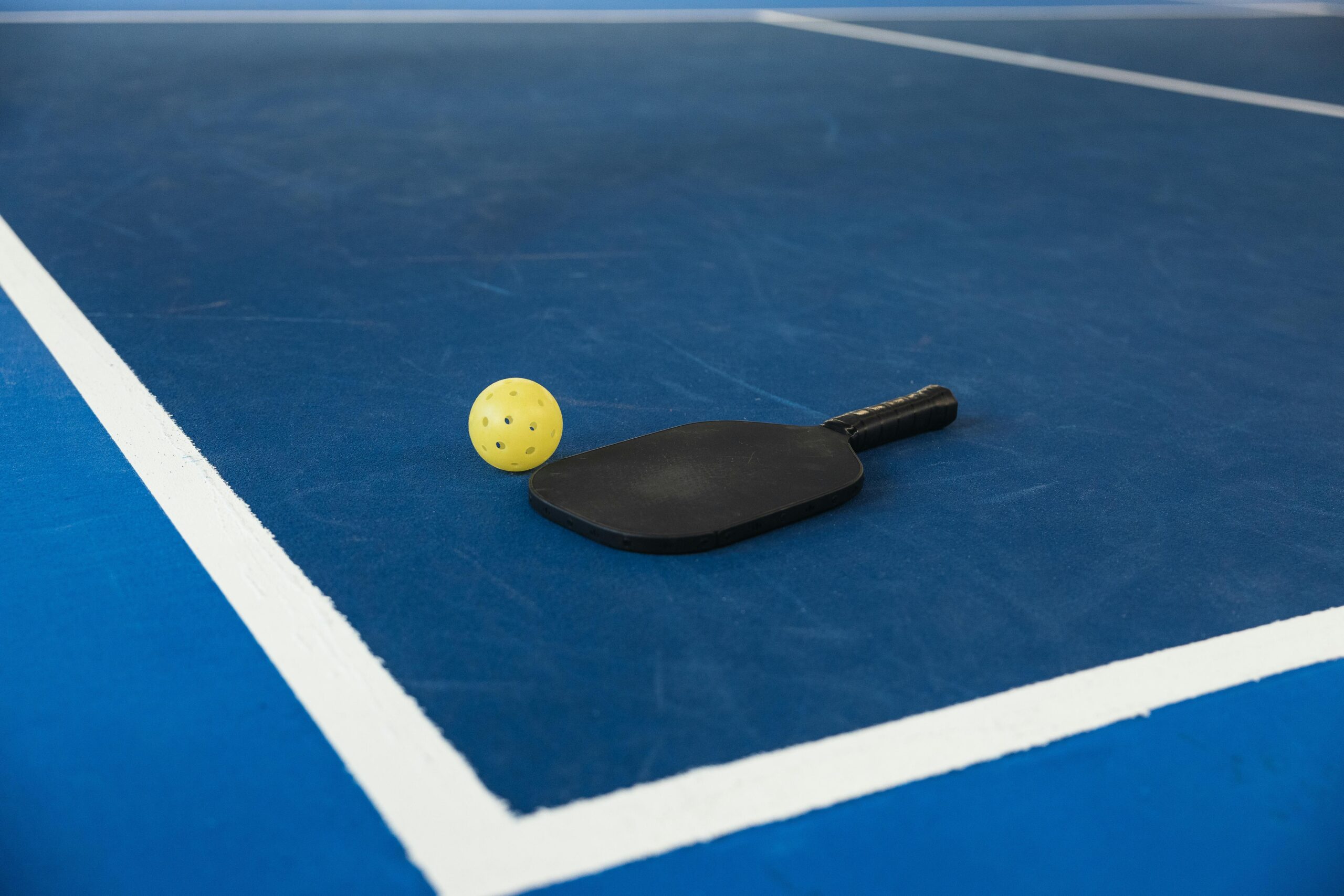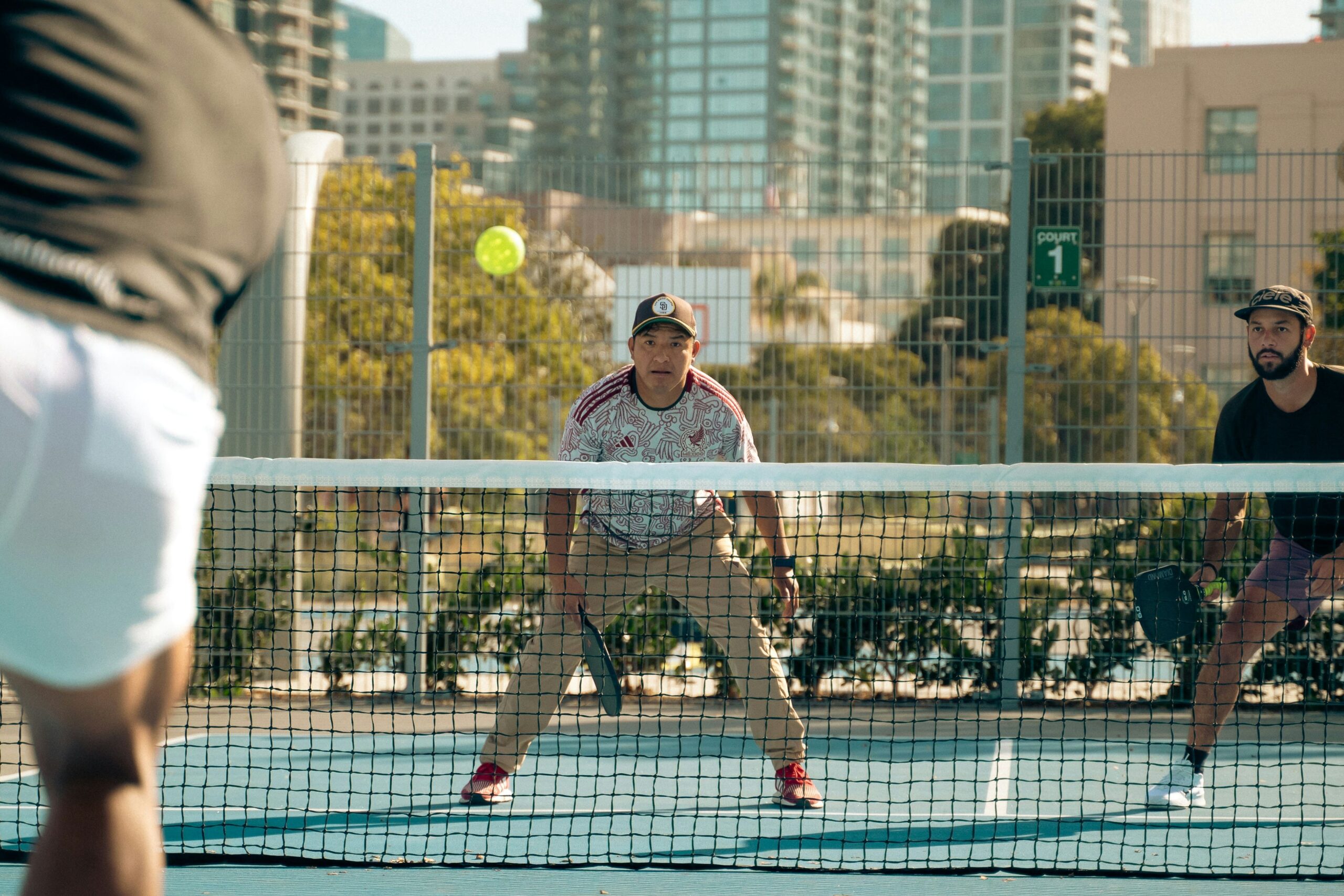If you’ve ever watched the legendary Bryan Brothers dominate the tennis doubles circuit, you’ve witnessed a masterclass in positioning and teamwork. Bob and Mike Bryan weren’t just fast or powerful—they knew exactly where each should be on the court to maximise their strengths. One brother consistently took the forehand middle while the other patrolled the net like a hawk, often switching sides mid-match to maintain their tactical edge.
This same logic of optimising player positioning applies in pickleball doubles, and that’s where stacking comes into play.
Now you might wonder, “Is stacking allowed in pickleball?”. Yes, stacking is completely legal in both recreational and competitive play, as long as players follow the correct serving and receiving positions according to the score.
Stacking may seem complicated at first, but once you understand the mechanics and the “why” behind it, it can drastically improve your doubles game, helping you cover more court, capitalise on strengths, and gain a strategic edge over your opponents.
What is Pickleball Stacking and Why Use it?
So, what is Pickleball Stacking? It is a doubles strategy that allows players to stay on their preferred sides of the court. It’s when both players start on the same side of the court and then shift positions mid-point (or after serve/return) to align themselves better tactically. Think of it as pre-planned movement for strategic gain.
If you are figuring out how to Understand Stacking in Pickleball, this will help.
Instead of returning to the traditional left-right alignment after each serve or rally, players “stack” by standing on the same side or switching sides after the serve or return. This allows partners to maximise their strengths, like keeping forehands in the middle or letting the more agile player cover wider angles. Understanding stacking starts with knowing the rules, practising communication, and recognising when it offers a strategic edge.
Now here’s a quick example to make this clearer:
🎯 Scenario: You’re a right-handed player with a strong forehand, and your partner is left-handed with a solid backhand. Using traditional positioning, one of you would always have your weaker shot (your backhand, their forehand) covering the middle of the court.
With pickleball stacking, you can arrange it so that your forehand and your partner’s backhand always control the centre. This lets you cover more high-percentage shots, attack with strength, and reduce unforced errors.
Result? You’ll win more points simply by putting your team’s strengths in the right place.
Pickleball Stacking Rules: How to Stack Legally
Before you start experimenting with pickleball stacking, it’s crucial to understand the basic rules. While stacking is fully legal, there are specific requirements you need to follow during serves and returns to avoid faults and confusion. Here’s how stacking works within the rules:
🥎 Stacking on the Serve
These are a few rules one should remember :
- The server must be on the correct side of the court (right or left) depending on whether the score is even or odd.
- The server’s partner can stand anywhere on the court, including on the same side as the server, this is the core of stacking.
- After the serve, players can switch sides immediately to return to their preferred positions.
⚠️ Important Tip: Make sure you and your partner know the correct server and side each time. Many faults happen when players forget their positioning during stacking.
🔄 Stacking When Returning the Serve
Stacking while receiving is a bit trickier, but still allowed. Make sure to remember these
- The receiver must stand in the correct box (right or left) based on the score.
- The receiver’s partner can again stand anywhere, often on the same side as the receiver, to prepare for a quick switch after the return.
- Once the return is made, the team can rotate or switch sides as needed.
If you need help with other rules related to pickleball, here is a comprehensive blog i wrote.
How to Play Pickleball: 8 Rules Beginners Always Get Wrong
How to Stack: Step-by-Step Guide
Let’s break down the actual mechanics of stacking, using the earlier example:
Scenario: You’re a right-handed player with a strong forehand. Your partner is a lefty with a strong backhand. You both want to control the middle — so you (righty) want to play from the left side, and your partner (lefty) prefers the right side.
📍 Goal: Keep your forehand (righty) and their backhand (lefty) in the middle, a smart stacking setup.
🎾 How to Stack While Serving
Setup – You are the server, and you’re starting from the even/right side (as per the score).Your partner stands on the same side as you, either just behind or slightly off the court — this is the “stacked” position.
After the serve – As soon as you serve and the return is hit, your partner quickly moves to their preferred side (right), and you shift to the left.
👉 Now you’re both in the ideal positions — you (righty) on the left, and your lefty partner on the right.
✅ Why it works: Since you’re serving, your team is not allowed to volley the return (it must bounce) — this gives your partner time to move into position before the third shot is played.


🎾 How to Stack While Returning Serve
Setup – The player who is legally supposed to return the serve (based on the score) stands in the correct court position. The non-returner (your partner) starts near the same side or sideline, either at the baseline or at the kitchen line, depending on your plan. This is the “stacked” formation.
After the return – The returner (you or your partner) hits the return and immediately crosses over to the preferred side. At the same time, the non-returner switches to the opposite side, so you end up in your stacked, ideal positions.
👉 Example – If you return from the right side, after hitting the return, you move left, and your partner moves right.
✅ Why timing matters – The third shot (after the return) comes very quickly, so you both need to switch positions fast and safely, ideally while staying ready for the shot.


Pickleball Stacking Strategy, Hand Signals & Communication
Pickleball stacking allows you to maximise your strengths, but to make it work, you need more than just positioning. You need clear communication, a shared strategy, and efficient hand signals to avoid confusion during the game.
🤝 Communication: The Glue That Holds Stacking Together
Without proper communication, even the best stacking setup can fall apart. Whether it’s a tournament or casual play, your team should always discuss:
- Who covers what zones (middle, sideline, lobs)?
- When to switch or stay after the serve or return.
- How to adapt if the opponent starts exploiting your pattern.
A simple pre-serve or pre-return conversation can be game-changing:
“Let’s stack so you take the forehands in the middle — I’ll call ‘switch’ if I see a lob.”
✋ Hand Signals in Pickleball Stacking: Make It Visual
Hand signals are critical when one partner has their back turned (especially the server). Here’s a quick refresher:
| Signal | Meaning |
| ✌️ Two fingers | Stay in current positions |
| ☝️ One finger | Switch sides after the shot |
| 👌 Open palm | Optional/flexible switch |
These signals are shown behind the back, so only your partner sees them. They help both players stay on the same page without alerting the opponents.
Sample Strategy: Using Stacking to Play to Strengths
Let’s revisit our earlier example: Player A has a strong forehand (right-handed), and Player B has a solid backhand and is left-handed.
Goal– Always keep Player A’s forehand in the middle and Player B’s backhand ready to counter drives or dinks down the line.
Stacking Strategy
- Serving Team
- Stack so Player A starts on the left (even) side.
- Player B shows ✌️ (stay) behind their back before Player A serves.
- After the serve, they hold position — Player A covers the middle with forehands.
- Receiving Team
- Stack similarly, with Player A in the left side again.
- Player B (receiver) shows ☝️ (switch) behind their back — meaning after the return, they’ll switch positions.
- After the return, Player A slides right while Player B crosses to left, keeping ideal positioning.
💡 This way, both players end up exactly where they’re strongest, regardless of the serve or return side. Consistency is key. You and your partner should develop a stacking system based on:
- Each player’s preferred shots.
- Serve/return patterns.
- Opponent tendencies — like exploiting backhands or hitting lobs.
It can be a gamechanger if you discuss stacking adjustments between games:
“They’re dinking to my backhand a lot — let’s try a switch signal next point.”
The stacking strategy isn’t static — it evolves during the match. The stronger your communication and your trust, the more fluid and effective your stacking will become.
Stacking for Lefties & Mixed Skill Levels: Smart Adjustments and Advanced Variations
In doubles pickleball, not all partnerships are created equal, and that’s where stacking truly shines. Whether you’re playing with a left-handed partner or teaming up with someone at a different skill level, smart stacking adjustments can help you get the most out of your strengths while covering for weaknesses.
If you are yet to find out your pickleball skill level guide,here is a comprehensive guide : –
The Truth About Pickleball Skill Levels (1.0 to 5.5+)
👉 Stacking for Lefties: Does Handedness Matter?
Absolutely. Handedness plays a huge role in stacking strategy. If one player is right-handed and the other is a lefty, stacking can allow both partners to position their forehands toward the centre, the most common area for attacking shots.
Scenario:
If you’re right-handed and your partner is a lefty, you may want to stack so your forehands meet in the middle, covering more court with your strongest shot. This setup is especially deadly in transition zones and during fast exchanges near the kitchen line.
This is often referred to as “mirror stacking”, an ideal setup that maximises offensive potential while reducing reliance on backhands.
👉 Stacking with Mixed Skill Levels
If one partner is more skilled or aggressive, stacking allows them to take charge of the middle and handle more of the high-pressure shots. For example, if you’re the stronger player:
- You may stack to cover the forehand middle and poach more balls.
- Your partner can play a supportive role by defending and resetting from their preferred side.
This helps balance roles without overwhelming the less experienced player.
👉 Half Stacking in Pickleball: A Simpler Path to Better Positioning
Half stacking is a fantastic option for players who want the positional benefits of pickleball stacking without the full complexity of switching after every point.
In this setup, you and your partner only stack during the serve or only during the return of serve, not both.
🧩 How Half Stacking Works
- On Serve – You use stacking only when serving. This means both players position themselves in a way that keeps your stronger forehands (or preferred shots) in the middle. After the serve, you switch into your desired positions.
- On Return – You play in traditional positions based on the score. This keeps things simple and avoids unnecessary movement or miscommunication during fast-paced returns.
✅ Why use it? It’s a great option if your team benefits from better middle coverage but wants to limit complexity, especially on returns where timing is tight.
When is half-stacking useful?
- When one player is still learning how to stack.
- Half stacking is less mentally demanding and a great stepping stone to full stacking.
- It’s also handy if one player isn’t confident with switching mid-play.
Key tip: Use clear verbal or visual signals to confirm whether you’re stacking on a given point. This helps avoid illegal positioning or service faults.
👉 Reverse Stacking in Pickleball: Breaking the Norm with Strategy
What is Reverse Stacking in Pickleball?
Reverse stacking is when a team doesn’t follow the usual strategy of keeping forehands in the middle. Instead, they position themselves based on individual strengths, even if it means their backhands face the center.
Why Use Reverse Stacking?
Teams might choose reverse stacking when:
- Both players have strong backhands, so it’s not a disadvantage.
- One player struggles with switching sides quickly, so they stay where they’re most comfortable.
- They want to mix things up and confuse opponents who expect standard stacking setups.
Example– Let’s say you’re right-handed and your partner is a lefty, but your partner has a wicked cross-court dink from the left side. In reverse stacking, you stay on the right side (even court) to keep them where they excel, even if that means your forehands are not both in the centre.
It goes against the usual “forehands middle” principle — but if it plays to your team’s strengths, it can be a game-changer.
When to Stack vs When Not to Stack
While pickleball stacking can give your team a real edge, it’s not always the right answer, especially when used with purpose. There needs to be clarity on when to stack and when not to stack, based on your team’s strengths, communication, and consistency.
So, when does it make sense to stack?
✅ When to Stack
- When partners have complementary strengths (e.g., one has a dominant forehand, the other a strong backhand), stacking ensures the stronger shots cover the middle.
- In lefty-righty pairs, stacking helps keep both players’ forehands in the centre — a huge advantage in controlling rallies.
- When one partner is stronger at the net or quicker on their feet, stacking positions them to play more aggressive shots.
- To strategically disrupt opponents who are used to traditional court positioning.
🚫 When Not to Stack
- If communication is weak, stacking can confuse mid-rally, especially when switching doesn’t happen cleanly.
- When players struggle with movement timing or footwork, frequent switches can lead to unforced errors.
- If stacking doesn’t lead to a clear advantage, or if it disrupts your rhythm more than it helps, it’s best to avoid it.
🔑 The key takeaway: Use stacking only when it adds clarity and strength to your gameplay, not just because it’s trendy. A well-timed traditional setup can sometimes outperform a poorly executed stack.
Elevate Your Game with Pickleball Stacking
To sum it up, pickleball stacking explained simply: It isn’t just a trend, it’s a proactive strategy that helps your team cover the court better and play smarter. It’s especially helpful in mixed-skill or lefty-righty pairs, but beneficial for any team that wants to control the middle and confuse the opposition.
From understanding how to stack, when to stack (or not), to mastering hand signals and advanced variations like half and reverse stacking, you now have the foundational knowledge to start stacking with purpose.
✅ Now it’s your turn: Practice these stacking strategies with your partner. Start with simple formations and signals, and adjust based on comfort and court situations. The more you experiment, the more stacking will feel natural and effective.



